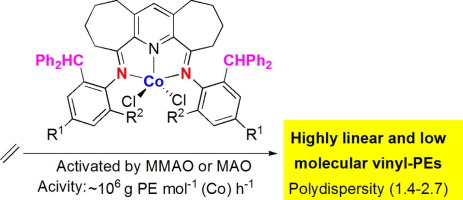当前位置:
X-MOL 学术
›
Eur. Polym. J.
›
论文详情
Our official English website, www.x-mol.net, welcomes your feedback! (Note: you will need to create a separate account there.)
Narrow dispersed linear polyethylene using cobalt catalysts bearing cycloheptyl-fused bis(imino)pyridines; probing the effects of ortho-benzhydryl substitution
European Polymer Journal ( IF 6 ) Pub Date : 2019-01-01 , DOI: 10.1016/j.eurpolymj.2018.11.010 Chantsalnyam Bariashir , Zheng Wang , Hongyi Suo , Muhammad Zada , Gregory A. Solan , Yanping Ma , Tongling Liang , Wen-Hua Sun
European Polymer Journal ( IF 6 ) Pub Date : 2019-01-01 , DOI: 10.1016/j.eurpolymj.2018.11.010 Chantsalnyam Bariashir , Zheng Wang , Hongyi Suo , Muhammad Zada , Gregory A. Solan , Yanping Ma , Tongling Liang , Wen-Hua Sun

|
Abstract The cycloheptyl-fused cobalt(II) chloride complexes, [2,3:5,6-{C4H8C(N(2-R1-4-R2-6-(CHPh2)C6H2))}2C5HN]CoCl2 (R1 = R2 = Me Co1, R1 = Me, R2 = CHPh2 Co2, R1 = Et, R2 = CHPh2 Co3, R1 = i-Pr, R2 = CHPh2 Co4, R1 = Cl, R2 = CHPh2 Co5, R1 = CHPh2, R2 = i-Pr Co6, R1 = CHPh2, R2 = t-Bu Co7, R1 = CHPh2, R2 = F Co8), have been prepared by a one-pot template approach. The molecular structures of Co1, Co6 and Co8 highlight the varying degrees of steric protection of the metal center imposed by the ortho-benzhydryl/-R1 group pairing. On activation with either MAO or MMAO, Co1–Co5 collectively displayed high activity (up to 2.87 × 106 g (PE) mol−1 (Co) h−1 at 40 °C) affording highly linear low molecular weight polyethylene (Mw range: 12.8–59.4 kg mol−1) with narrow polydispersities (Mw/Mn range: 1.4–2.7). End-group analysis of the polymers highlights the importance of both β-H elimination and chain transfer to aluminum as termination pathways. In relative terms, MMAO proved a marginally more effective activator than MAO with the catalytic activity, in either case, falling in the order: Co1 > Co5 > Co2 > Co3 > Co4. In marked contrast, the 2,6-(CHPh2)2-substituted precatalysts, Co6, Co7 and Co8 gave, in the presence of the same aluminoxane activators, only trace amounts of polyethylene.
中文翻译:

使用带有环庚基稠合双(亚氨基)吡啶的钴催化剂的窄分散线性聚乙烯;探讨邻二苯甲基取代的影响
摘要 环庚基稠合氯化钴 (II) 络合物 [2,3:5,6-{C4H8C(N(2-R1-4-R2-6-(CHPh2)C6H2))}2C5HN]CoCl2 (R1 = R2 = Me Co1, R1 = Me, R2 = CHPh2 Co2, R1 = Et, R2 = CHPh2 Co3, R1 = i-Pr, R2 = CHPh2 Co4, R1 = Cl, R2 = CHPh2 Co5, R1 = CHPh2, R2 = i- Pr Co6, R1 = CHPh2, R2 = t-Bu Co7, R1 = CHPh2, R2 = F Co8),已通过一锅模板法制备。Co1、Co6 和 Co8 的分子结构突出了由邻二苯甲基/-R1 基团配对施加的金属中心的不同程度的空间保护。在用 MAO 或 MMAO 活化时,Co1–Co5 共同显示出高活性(在 40 °C 时高达 2.87 × 106 g (PE) mol−1 (Co) h−1),提供高度线性的低分子量聚乙烯(Mw 范围: 12.8–59.4 kg mol-1),多分散性窄(Mw/Mn 范围:1.4–2.7)。聚合物的端基分析突出了β-H消除和链转移到铝作为终止途径的重要性。相对而言,MMAO 被证明是一种比 MAO 更有效的活化剂,具有催化活性,在任何一种情况下,顺序为:Co1 > Co5 > Co2 > Co3 > Co4。与此形成鲜明对比的是,在相同铝氧烷活化剂的存在下,2,6-(CHPh2)2-取代的预催化剂 Co6、Co7 和 Co8 仅产生痕量的聚乙烯。
更新日期:2019-01-01
中文翻译:

使用带有环庚基稠合双(亚氨基)吡啶的钴催化剂的窄分散线性聚乙烯;探讨邻二苯甲基取代的影响
摘要 环庚基稠合氯化钴 (II) 络合物 [2,3:5,6-{C4H8C(N(2-R1-4-R2-6-(CHPh2)C6H2))}2C5HN]CoCl2 (R1 = R2 = Me Co1, R1 = Me, R2 = CHPh2 Co2, R1 = Et, R2 = CHPh2 Co3, R1 = i-Pr, R2 = CHPh2 Co4, R1 = Cl, R2 = CHPh2 Co5, R1 = CHPh2, R2 = i- Pr Co6, R1 = CHPh2, R2 = t-Bu Co7, R1 = CHPh2, R2 = F Co8),已通过一锅模板法制备。Co1、Co6 和 Co8 的分子结构突出了由邻二苯甲基/-R1 基团配对施加的金属中心的不同程度的空间保护。在用 MAO 或 MMAO 活化时,Co1–Co5 共同显示出高活性(在 40 °C 时高达 2.87 × 106 g (PE) mol−1 (Co) h−1),提供高度线性的低分子量聚乙烯(Mw 范围: 12.8–59.4 kg mol-1),多分散性窄(Mw/Mn 范围:1.4–2.7)。聚合物的端基分析突出了β-H消除和链转移到铝作为终止途径的重要性。相对而言,MMAO 被证明是一种比 MAO 更有效的活化剂,具有催化活性,在任何一种情况下,顺序为:Co1 > Co5 > Co2 > Co3 > Co4。与此形成鲜明对比的是,在相同铝氧烷活化剂的存在下,2,6-(CHPh2)2-取代的预催化剂 Co6、Co7 和 Co8 仅产生痕量的聚乙烯。


























 京公网安备 11010802027423号
京公网安备 11010802027423号